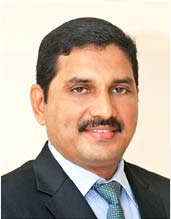Aquaculture produces more than half of the fish consumed worldwide. However, due to a fast-growing population, the demand for fish as one of the best protein sources significantly exceed its supply. Global aquaculture production is expected to reach 152 million tons by 2030. This necessitates a large-scale increase in output through the expansion of farming areas and the intensification of production technologies. The early growth phase of aquaculture was marked by collecting wild juveniles and natural feeds in vast coastal farming regions to produce economically important finfish and shellfish. The lack of environmental awareness or specific legislation in the early days aided the rapid expansion of aquaculture, notably in Asia-Pacific.
Intensive rearing methods and techniques have evolved in the rapid growth phase of aquaculture since the 1970s. Commercial hatchery and farming technologies for carps, tilapia, catfish, and shrimps were developed, forming the mainstay in Asian aquaculture production. These included high stocking densities, intense feeding of formulated feeds, improved genetic strains, and the emergence of high-health stocks. Intensifying aquaculture operations necessitated a race to develop complete feeds that could meet all of the known nutritional needs of fish. Improved water quality management, including using aeration devices, water recirculation systems, feed supplements and probiotics, new genetically enhanced breeds, and more effective aquatic health management strategies, including vaccines against a wide range of infectious diseases and pathogens, became necessary. A range of precision management tools in aquaculture has recently emerged due to the integration of information and communication technologies (ICT), including autonomous feeding, precision nutrition, and real-time monitoring of environmental variables, which are poised to change the way aquaculture production is done in future.
Impacts of intensive aquaculture
Advanced aquaculture systems necessitate a variety of inputs for the consumption of the reared animal and rigorous environmental management. However, the dangers of discharging effluents into the environment represent a substantial threat to aquaculture's long-term viability worldwide. In the liquid and solid components (sludge) removed after each crop, high protein diets provided to fish or shrimp release nitrogenous and phosphorus nutrients to the environment. They may also discharge hazardous gases from each crop during decomposition, in addition to the excessive use of fossil fuels. Eutrophication and water quality concerns could emerge from increased sedimentation and nutrient runoff. Indiscriminate intensification of aquaculture is the leading cause of the rapid onset and spread of aquatic diseases. Environmental pressures, pollution, conflicting resource uses, hazards to aquaculture from non-aquaculture sources, and climate change are all relevant factors. The disruption caused by new-age pandemics like Covid19 has had a negative impact on aquaculture, indicating the need for new approaches to production, trade, and seafood consumption.
"Aquaculture production intensification comes at a cost to the environment, so sustainable intensification is the key to this expansion. Modern technologies that have shown to be long-lasting and with low impact on the environment must be encouraged, and adequate human resources must be developed to ensure that these production systems operate efficiently."
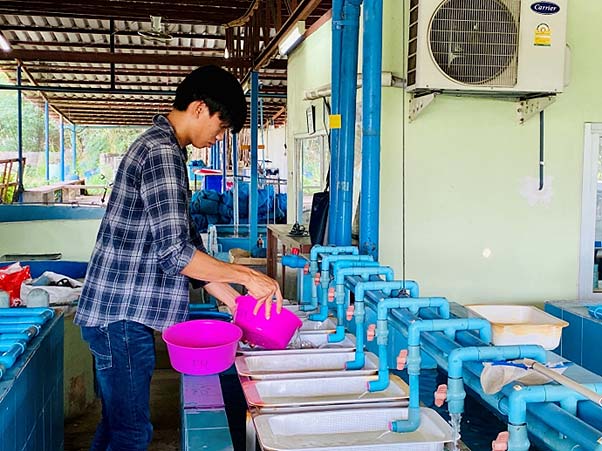
Tilapia hatchery system, AIT, Thailand
Advanced aquaculture systems
During the last 50 years, aquaculture has benefited from various technological advancements, including closing the reproductive cycle of economically important finfish and shellfish, species diversification, live and formulated feeds, water quality management, disease management, and genetic improvement through selective breeding. Research on aquaculture nutrition has involved using novel ingredients, mainly plant-based meals (soybean and other grain-based), insect meal, single-cell proteins, and microbial protein, among others, besides the emergence of functional feeds with exciting pharmacological innovations. There has been a significant improvement in feed technology development, particularly in feed formulation and the introduction of advanced feed extrusion machinery over the past several decades.
Disease diagnostics and surveillance are emerging areas critical in supporting the rapid growth in aquaculture, especially given the frequent transboundary movement of aquatic animals. Biosecurity in aquaculture facilities involves physical, chemical and biological measures to control pathogens. Physical measures use temperature, sunlight, and UV rays to inactivate viruses and bacteria. Chemical measures use chlorine, formalin, iodophor, hydrogen peroxide, etc., as disinfectants. The dose and exposure time are critical in the efficacy of these measures. Biological measures include vaccination, use of immunostimulants, and the use of specific-pathogen-free (SPF) or pathogen-resistant (SPR), pathogen-tolerant (SPT) or all-pathogen-exposed (APE) stocks.
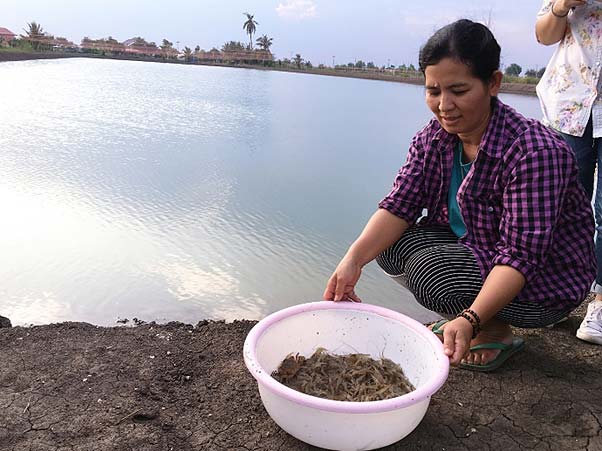
A traditional shrimp farm in Thailand
Sustainable intensification of aquaculture production requires clever manoeuvring of production systems that can realize the maximum biomass with the least quantity and cost of inputs while inflicting the least impact on the environment. Some of the sustainable yet intensive production systems are described here.
Recirculating Aquaculture Systems (RAS)
RAS is a novel aquaculture production system that does not require the used water to be exchanged during the rearing period. However, the water quality is maintained by a recirculating system involving a series of external filters – both mechanical and biological filters. While the daily water exchange requirement in a conventional shrimp production system can be as high as 30%, this can be reduced up to only 5% replaced to top up the evaporation loss. With limited effluents from RAS to the environment, this is deemed environment-friendly. However, this system needs an array of pumps, aerators, and filtration equipment operating continuously throughout the production cycle, making it highly capital intensive and risky. The system should be supervised by more qualified technical personnel than a conventional less-intensive aquaculture production system. Although most RAS are tank-based, recent innovations include pond-recirculating methods often used for shrimp farming. More recently, the in-pond-raceway systems (IPRS) for intensive farming of carps and tilapia within a larger production area for treating used water and recirculating within the pond have also been developed.
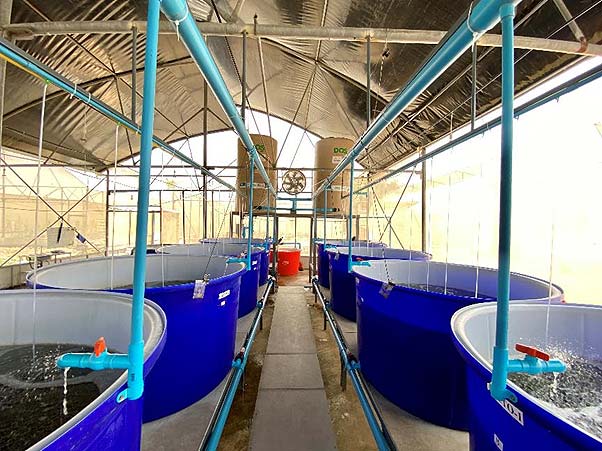
A small-scale recirculating aquaculture system (RAS) for shrimp at AIT, Thailand
Biofloc production systems
Biofloc systems are different from RAS. This system thrives based on the activity of waste-reducing bacteria and the frequent addition of organic carbon sources for bacterial proliferation and reduction of toxic metabolites (ammonia, nitrite, etc.) from fish waste and unused feed. There is no water recirculation, but rearing water is recycled within the system without any external filtration. The nitrogenous waste materials are converted to edible protein in the form of flocs of minute living flora and fauna. These 'living flocs' supplement the feed for fish or shrimp in the system. Biofloc also reduces water quality issues while providing additional food to the reared animal. Therefore, the Biofloc is considered a self-cleaning aquaculture production system with excellent feeding efficiency. Over the past few years, several modifications to the Biofloc systems, such as semi-biofloc and aquamimicry systems, have been evolved in many Asian countries, including Indonesia, Thailand, and Vietnam. Like RAS, Biofloc also needs continuous aeration and careful management, so the production can be risky unless supervised by a qualified technician.
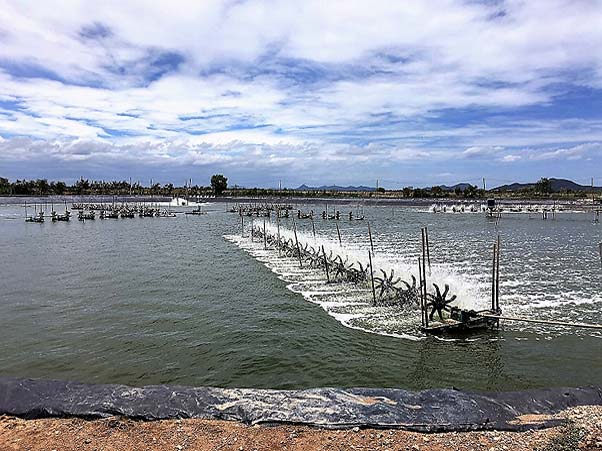
An intensive shrimp farm using a semi-biofloc production, Thailand
Aquaponics
Aquaponics integrates aquaculture and hydroponics employing a recirculating aquaculture system, mainly in freshwater. Hydroponics is the soil-less cultivation of plants grown in a nutrient medium without soil. As fish production systems generate nutrient-rich effluents during water exchange and harvesting, integrating this with a plant production system will benefit. In aquaponics, effluents from the fish unit are directed through a RAS to a channel or media bed where planting is done. This system has been most suitable for producing vegetables such as lettuce, tomatoes, cucumbers, etc. The plants utilize the nutrients from fish to grow. This is an efficient system for producing both fish and plants without using inorganic fertilizers for plants and no effluent discharge, making it a highly efficient and environmentally friendly food production system.
Cage farming systems
Cage aquaculture is a production system in which fish are held in floating or submerged net pens. It encloses the fish in a cage or net basket in an existing water resource, allowing water to pass freely between the fish and the enclosed water body, permitting water exchange and waste removal into the surrounding water. This culture system can be installed in freshwater rivers and lakes, coastal and oceanic areas, used for several shellfish and finfish species. Different types of cages are prevalent such as fixed type cages, floating cages, submerged cages and submersible cages. The advantage of cage culture is that fish can be confined to facilitate feeding, harvesting, and other management procedures. When cages are installed in ponds, fish can be harvested without draining ponds. However, one of the major disadvantages of cage farming, when installed in open water bodies, is its impact on the environment, particularly from the effluent discharge and their trophic interactions with the wild fish in rivers or lakes.
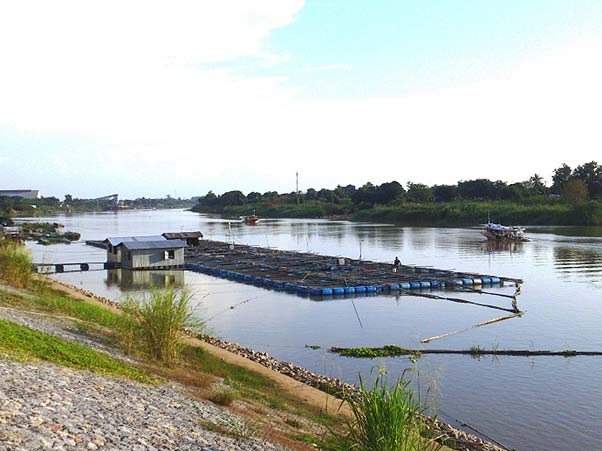
River cage farm for tilapia, Thailand
IMTA with cage culture systems
Integrated multi-trophic aquaculture (IMTA) can be considered a marine aquaponics system. These are primarily suitable for reducing the environmental impact of offshore farming systems such as cage culture. Cage culture is different from the conventional pond culture systems. The fish are reared in closed containments (cages) in open waters, either suspended or fixed in inland, coastal, or marine areas. The potential for pollution from cage culture is relatively high in the large open waters. The concept of IMTA is to reduce or eliminate the chances of pollution by growing several extractive species in the vicinity of installed cages. The extractive species include seaweeds, shellfish such as oysters, mussels, abalones, etc. or high-valued species such as lobsters that help absorb the nutrients. Their inclusion help integrates all possible trophic levels in the ecosystem to utilize the nutrients discharged from fish cages which would otherwise pollute the entire environment. IMTA systems have been deployed mainly in China's coastal and marine farming areas.
Coping with the new normal in aquaculture
With the increasing disruptions impacting the value chain, the need for social distancing in aquaculture is increasingly realized with reduced human interventions and increased efficiency and accuracy by remotely maneuvered operations. Integrating technology, innovation, and entrepreneurship is vital to finding new solutions for emerging challenges. This is accomplished mainly by applying digital technologies, biotechnology, bioengineering, nanotechnology, and fast-evolving genome engineering and associated technologies.
Some path-breaking technologies that can drastically influence aquaculture include the use of the internet of things (IOTs) and the application of big data using artificial intelligence (AI) and machine learning in better environment control and efficient management of production systems. Physical and chemical sensors integrated with ICT tools have improved the feed management for high-value fish by entirely automating the feeding system by tracking the behavior of fish (for example, their appetite and feeding activity), precisely delivering the feed for more efficient utilization. The use of computer vision and image analysis have enabled accurate counting of fish stock and collection/analysis of vital parameters related to growth, biomass, and animal welfare. With the least human interference, drones and underwater remotely operated vehicles (ROVs) help control many aquaculture operations. Blockchain technology which enables the maintenance of a transparent and publicly accessible digital database, incorruptible by anyone, has great applications in the aquaculture supply chain and ensures seafood traceability.
Future outlook
Aquaculture is widely regarded as one of the most efficient ways of supplying high-quality food and nutrition to the world's growing population. Intensification within the scarce land and water resources is a viable option for meeting the estimated production goals. However, aquaculture production intensification comes at a cost to the environment, so sustainable intensification is the key to this expansion. Modern technologies that have shown to be long-lasting and with low impact on the environment must be encouraged, and adequate human resources must be developed to ensure that these production systems operate efficiently. One of the most challenging questions is how new technologies can propel small-scale farmers. Because small-scale farmers comprise most of the producer segment, providing them with the appropriate infrastructure and financial support will be critical for the broader adoption of such systems and a more significant impact. We can improve production and consumption using cutting-edge technologies and techniques and offer safe, high-quality seafood to be part of an innovative supply chain. The most radical technology-enabled production systems will be the future to maintain competitiveness while ensuring environmental, economic, and social sustainability in aquaculture.

